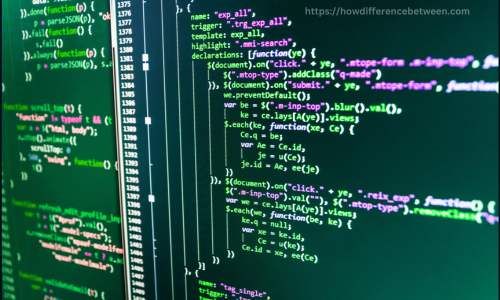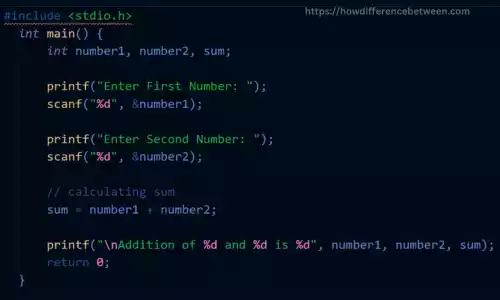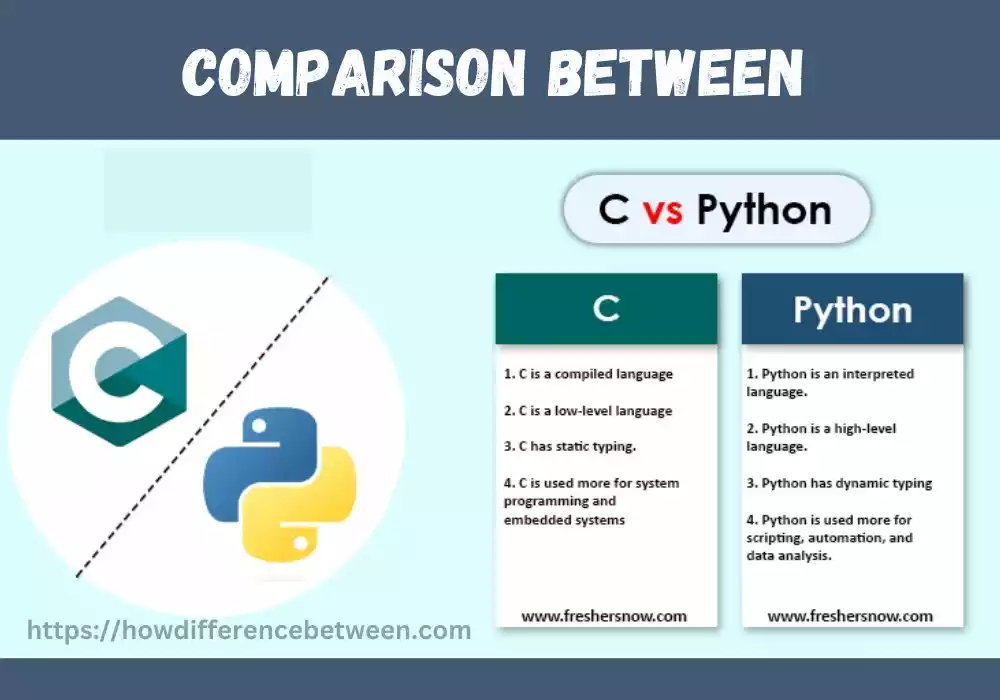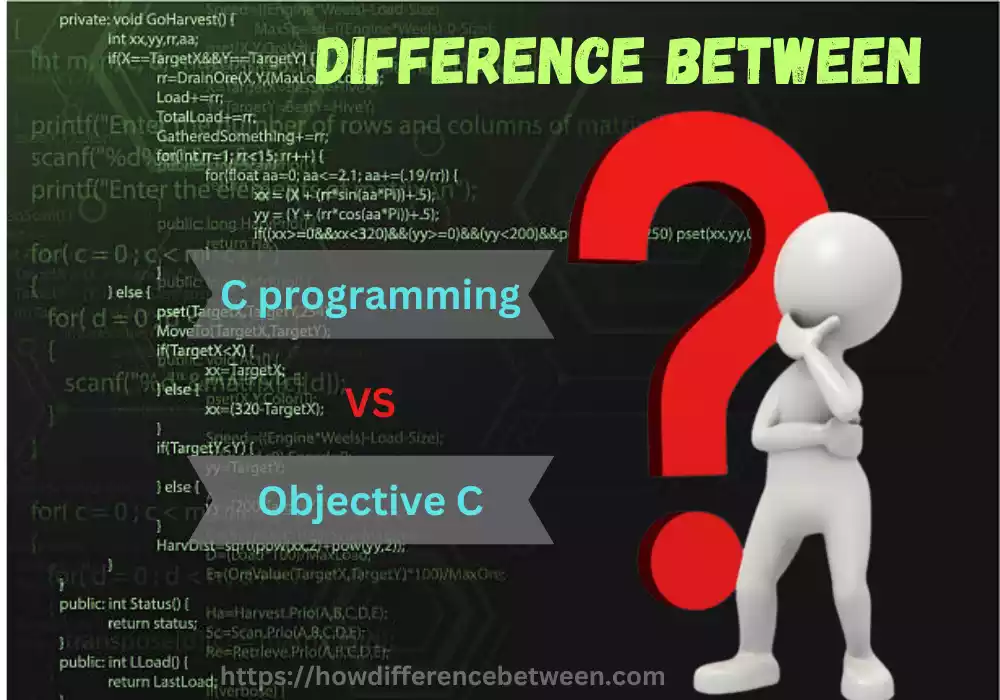Introduction to Python and C Language
Python and C Languages are two widely-used programming languages used for projects of various domains. C Language is particularly valued for its low-level programming abilities and efficiency. This article compares their advantages, features, applications, use cases and use cases so you can choose which will best meet the requirements for your project.
Overview of Python language
Python is an interpreted high-level programming language distinguished by its elegant syntax and user friendliness, designed by Guido van Rossum and released into general usage in 1991. Python emphasizes code readability making it suitable for novice and expert programmers alike.

Advantages of Python
Python has many advantages which contribute to its popularity in different domains.
Here are some of the key benefits of using Python:
- Readability and Simplicity
- Python is highly readable because of its clean, easily understood syntax.
- Indentation of code blocks ensures consistency in formatting and enhances code readability.
- Python’s simplicity makes it easier for beginners to learn and maintain code.
- The Large Standard Library Packages and Third-Party packages:
- Python has a large standard library, which includes a variety of modules and functions to perform common tasks.
- The standard library contains modules for file I/O and networking, as well as regular expressions.
- Python offers access to numerous third-party libraries and packages, such as NumPy and Pandas. Other popular options include Django and Flask.
- These packages allow developers to take advantage of pre-built functionality and save time by leveraging it.
- Cross-Platform Compatibility:
- Python code written using this programming language can run across several operating systems.
- The portability allows developers to write their code once, then deploy it across multiple platforms such as Windows macOS and Linux.
- Productivity and rapid development:
- Python’s simplicity, ease of use and speed contribute to increased productivity.
- The built-in data structure and concise syntax of the language simplify the implementation and execution of complex algorithms.
- Python offers solutions for many programming challenges through both its standard library and third-party packages.
- Rapid development of web apps is possible with frameworks such as Django or Flask.
- Interpreting Nature and Interactive Environment
- Python allows developers to write programs without prior compilation and run them line by line without errors or compiling needed for running code.
- This allows for rapid prototyping and experimentation.
- Python offers interactive shells such as the Python RePL (Read-Eval Print Loop) where code can run interactively. This makes it perfect for exploring programming ideas and testing them.
- Support for Multiple Programming Methodologies
- Python provides support for multiple programming paradigms such as procedural programming, object-oriented programming and functional programming.
- The framework’s adaptable nature enables developers to select an ideal approach for every project by taking advantage of each paradigm’s strengths.
- Community and Documentation
- Python enjoys the support of an energetic community of developers.
- Because this language is community-driven, there are numerous resources, tutorials, and forums where developers can get assistance or share knowledge.
- Integrating and Extending:
- Python is easily integrated with any other language, allowing developers the ability to use existing code and libraries.
- The Python/C API allows for robust integration with C/C++ code via modules such as ctypes.
- Python supports the integration of popular databases, web-services, and external tools. This allows for seamless connectivity and interoperability.
Use Cases and Applications of Python
- Web Development:
- Python offers several frameworks, such as Django and Flask, that simplify web development.
- Django provides a high-level, batteries-included approach for building robust and scalable web applications.
- Flask is a lightweight framework designed to enable developers to easily build customizable web apps and APIs quickly with Python.
- Together with its associated frameworks, Python makes an excellent platform for developing dynamic websites and applications quickly and cost effectively.
- Data Analysis and Scientific Computing:
- Python has become a popular language for data analysis, thanks to libraries like NumPy, Pandas, and SciPy.
- NumPy provides efficient numerical operations and multi-dimensional array manipulation.
- Pandas offers data structures and data analysis tools, making it easy to manipulate and analyze structured data.
- SciPy provides an expansive set of scientific computing capabilities, from optimization and signal processing through linear algebra and machine learning.
- Python along with these libraries is widely utilized for data analysis, scientific research, and machine learning applications.
- Artificial Intelligence and Machine Learning:
- Python has gained immense traction in artificial intelligence (AI) and machine learning (ML), particularly with tools like.
- TensorFlow, PyTorch, and scikit-learn providing powerful solutions for building and training machine learning models.
- TensorFlow and PyTorch are deep learning frameworks widely used for neural network modeling and training.
- scikit-learn offers a comprehensive set of tools for various ML tasks, including classification, regression, clustering, and dimensionality reduction.
- Python’s simplicity, combined with its rich ecosystem of ML libraries, makes it a popular choice for AI and ML projects.
- Automation and Scripting:
- Python’s ease of use and concise syntax make it well-suited for automation and scripting tasks.
- It can automate repetitive tasks, such as file manipulation, data processing, and system administration.
- Python’s standard library provides modules for interacting with the operating system, accessing files, and handling data formats like CSV and JSON.
- With frameworks like Selenium, Python can automate web testing and browser interactions.
- Python is often used for scripting in areas like DevOps, system administration, and network automation.
- Internet of Things (IoT):
- Python’s lightweight nature and extensive libraries make it suitable for IoT applications.
- Libraries like Adafruit CircuitPython and MicroPython provide simplified APIs for controlling and interacting with hardware devices.
- Python’s versatility enables developers to connect and communicate with sensors, actuators, and other IoT components.
- Python can be used to develop IoT prototypes, build IoT analytics platforms, and create IoT automation solutions.
- Game Development and Graphics Programming:
- Python, along with libraries like Pygame and Panda3D, can be used for game development.
- Pygame is an established library for creating 2D game content while Panda3D serves as an all-inclusive 3D engine.
- Python’s ease of use and simplicity makes it ideal for rapid prototyping and developing game logic quickly and efficiently.
- Python can also be utilized for graphics programming, image processing and computer vision applications.
- Scripting for Software Applications:
- Many software applications and tools provide scripting interfaces using Python.
- Python scripting language allows software such as Blender (3D modeling), Autodesk Maya (animation and VFX) and GIMP (image editing) that supports.
- Python to extend their functionalities, automate workflows and provide personalized user experiences.
- Server-Side Development:
- Python is widely used for server-side development, thanks to frameworks like
Overview of C Language
Dennis Ritchie introduced C Language into general purpose computing during the 1970s as an efficient low-level general programming language that closely adhered to hardware programming capabilities. Today it remains popular due to its ease of use and strong performance characteristics.

Advantages of C Language
The C language has many advantages which contribute to its continued popularity in different domains.
- Efficiency and Performance
- C is a very low-level programming language which provides direct access hardware and system resources.
- This allows for more efficient memory manipulation and management, which results in a faster and optimized code execution.
- C is a very fast language, which makes it ideal for systems-level programming, embedded system development, and games.
- Portability:
- C code can easily be compiled on different operating systems and platforms with minimal changes.
- Numerous compilers support it and its syntax is defined by ISO C.
- Portability makes software development simple across platforms and systems.
- Large Standard Library
- C has a rich library of standard functions that include essentials for tasks such as input/output, string manipulation, allocation of memory, and mathematical operations.
- Standard libraries allow developers to perform operations that are common without needing to write new code, saving them time.
- Flexible Low-Level Control and Flexibility:
- C allows for fine-grained control of memory allocation, system resources, and manipulation.
- This allows for direct manipulation of pointers. It enables efficient implementation of data structures and algorithms.
- C is flexible, allowing developers to adapt code to hardware and performance requirements.
- The Procedural Programing Paradigm
- C is based on a procedural paradigm that emphasizes a step-bystep approach to solving problems.
- It is based on the functions and allows code to be organized into modular units which can be easily understood.
- The Community is a vast resource:
- C is supported by a large, active developer community.
- C is a community-driven language, which means that there are many resources, tutorials and forums available for different uses.
- C is an extremely popular language for libraries and tools.
- Interoperability:
- C is easily compatible with other programming languages like C++, Java and Python.
- This interoperability allows for developers to leverage libraries in different languages and optimize performance-critical areas.
- Software Development:
- C is widely used to develop system software including operating systems and device drivers.
- Direct hardware access, low-level hardware control and efficiency make it ideal for managing system resources.
- Legacy Code and Maintenance
- C has been around several decades. This means that there is a large amount of legacy C code.
- C is still used in many critical applications and systems, so knowing C code is essential to maintenance and enhancement.
- Education and Learning
- C is used in many computer science and programming classes as an introduction to the language.
- The syntax and concepts of this program are simple.
C is a powerful language that has many advantages. It’s widely used for applications with high performance requirements, system-level programs, embedded systems and other situations where efficiency and low-level control are important.
Use Cases and Applications of C Language
C is widely used across many domains due to its portability, efficiency and low-level control.
Here are a few prominent C applications and use cases:
- System Software and Operating System:
- C is widely used to develop system software including kernels, operating systems, and device drivers.
- The low-level controls and direct hardware access make it ideal for managing system resources, and interacting with components.
- Embedded systems:
- C is used to program embedded systems, or computer systems that are embedded in larger machines and devices.
- C is a great choice for embedded systems, which often have limited resources.
- Game Development:
- The game industry uses C because of its efficiency and direct access to hardware.
- C is used extensively in game engines and graphics libraries such as Unity Unreal Engine and DirectX for performance-critical components.
- C allows developers the ability to optimize code in real-time rendering and audio processing.
- Compilers and interpreters:
- C is used for developing compilers, language runtime environments and interpreters.
- C is used to develop compilers and interpreters for many programming languages such as C++ and Python, including their compilers and interpreters.
- Networking and network programming:
- C is used to develop network protocols, servers, and applications.
- The low-level memory management and control of the system are very useful for optimizing network performance and managing resources.
- Included in the applications are firewalls, network routers and VPN software.
- Financial Systems:
- C is used widely in the development and implementation of high-frequency trading platforms, financial systems, and other software.
- Its low-level controls and efficiency make it ideal for processing large amounts of financial data, and for executing complex algorithms.
- Real-Time Systems:
- C is used in real-time system that requires precise timing and responsiveness such as aerospace and defence systems, robotics and industrial automation.
- These applications are suitable because it can handle time-sensitive tasks and control hardware directly.
- Cryptography and security:
- C is used in cryptographic algorithms and secure communication protocols.
- The low-level control allows developers to efficiently implement complex encryption algorithms.
- Medical and Healthcare devices:
- The development of medical devices and healthcare equipment, such as patient monitoring systems and imaging equipment, includes C.
- These applications require a high level of efficiency, low-level controls, and real-time capability.
- High-Performance Computing:
- C is used in applications requiring high computational performance, such as High Performance Computing (HPC).
- It allows efficient parallel programming with libraries such as OpenMP and MPI. This allows the development of performance-critical and scalable applications.
- Legacy Code Maintenance
- C has been used for many decades. This means that there is a large amount of legacy code.
- C code is still used in many critical applications and systems, which require ongoing maintenance.
C is a popular language for embedded systems and applications that require direct hardware access. Its portability, efficiency and low-level control make it an ideal choice.
Comparison between Python and C Language
Python and C are distinct programming languages, with different design principles and use cases.
This is a comparison of Python and C from various perspectives:
- Syntax and Readability
- Python’s syntax is clean, concise and focuses on readability. It uses indentation for defining blocks of code.
- C uses a complex syntax that focuses on efficiency and low-level control.
- Easy of use and learning curve:
- Python is beginner-friendly because of its gentle learning curve. The high-level abstractions of Python and its extensive standard library make development easier.
- Due to its low level nature and manual management of memory, C is a more difficult language to learn. It is important to understand concepts such as pointers and memory management.
- Performance:
- C has a high performance because it allows direct control of system resources and memory. C is used for performance-critical applications.
- It offers a variety of libraries and tools to optimize performance. Performance-critical code written in C can also be integrated with Python.
- Memory Management
- Python’s automatic memory management (garbage collecting) frees developers from manually allocating and dealing with memory.
- Manual memory management is required in C.
- Abstraction Level:
- Python is an abstraction-based language. It simplifies the development process and allows for faster Prototyping.
- C is an accessible programming language which permits fine control over system resources. It allows developers work at a low level and optimize their code for efficiency.
- Application Domains
- Python has long been utilized as an effective solution in website development, data analytics, artificial intelligence research and scripting applications.
- C is widely utilized to develop operating systems, embedded devices, games and applications requiring high performance.
- Portability:
- Python’s extensive libraries and interpreted nature make it highly portable. Python programs run on different platforms without requiring any modifications.
- It is possible to make C code portable but this may require extra effort in order to deal with platform-specific dependencies.
- Development Speed
- Python’s high-level abstractions and simplicity contribute to faster development. It is faster to develop than C.
- Due to the manual memory management, and lower-level controls, C can often require more time and effort.
- Ecosystems and Libraries
- Python is a huge ecosystem that has many libraries and frameworks. It has libraries for web design, scientific computing and machine learning.
- C has an ecosystem that is mature, especially for embedded systems and system-level programming. It has libraries and tools that are tailored to specific uses, but not as many as Python.
- Community and Support
- Python and C both have active and large communities that provide support, resources and documentation.
- Python’s community has a reputation for inclusivity, accessibility and the availability of learning materials.
The decision between Python and C is based on the requirements of the project. Python’s readability and extensive libraries are ideal for rapid development, high-level tasks, and scripting. C’s low level control, efficiency and direct access to the system make it ideal for embedded systems, performance-critical systems and system programming.
Learning Curve and Community Support
Learning Curve: Python offers an exceptionally gentle learning curve for newcomers to the language. The syntax has been specifically created to be easy for both readers and writers, prioritizing readability and simplicity over brace usage; instead indentation is often employed instead to increase code readability. Python offers an impressive standard library, high-level abstractions, as well as dynamic type system which offers greater development flexibility by eliminating explicit declaration of types altogether.
C is more difficult to learn compared to Python due to its lower level programming language nature and complex syntax that involves explicit type declarations and memory manipulation; its learning curve can be steeper. C requires an advanced understanding of concepts like memory management, pointers and manual memory allocation; being closer to machine provides more control of system resources while being easier than Python for controlling resources in general. Learning C provides great insight into computer architecture as well as programming at its base levels.
Community Assistance: Both Python (and C) have extensive and active communities that offer support, documentation and other essential resources for their respective platforms.
Python has long been known for its vibrant and inclusive community environment, boasting an abundant ecosystem of frameworks and libraries as well as extensive support. The official Python website features extensive documentation, tutorials and guides while its community approach ensures there are numerous online forums, discussion group platforms, Q&A services for developers seeking information or seeking to share knowledge. Furthermore, its capabilities can be further expanded via third-party libraries found through Python Package Index.
C is widely recognized for its community support in areas of embedded systems development, low-level programming and system programming. This community offers resources, forums and documentation specifically suited for C developers. C++ also often forms the core of multiple programming communities where programmers can exchange code with each other while asking questions, exchanging knowledge or seeking assistance online communities or forums.
Python’s widespread applications and high level of popularity has resulted in an ever-wider community, offering ample documentation, libraries and active online support compared to C. It offers both developers valuable resources as well as ongoing assistance through both communities.
Choosing the Right Language for Your Project
The right programming language depends on a number of factors.
- Project Requirements
- Assess the requirements for your project. Take into account factors like performance, scalability and complexity, compatibility with platforms, available libraries and frameworks, etc.
- Decide if your project requires low level control, direct access to hardware, or high level abstractions.
- Project Domain and Usecase:
- There are different programming languages that are more suitable for certain domains. Think carefully about what type of project you are engaged in – for instance web development, data analytics, system programming or AI are among your options.
- Discover which languages are appropriate for your project, and select those most suited.
- The Productivity and Development Speed of a Project:
- Some languages, such as Python, place a high priority on development speed and user-friendliness. These languages have extensive libraries and higher-level abstractions.
- Consider if the project needs rapid prototyping or quick iterations.
- Performance and Efficiency
- Consider languages such as C or C++ if your project includes computationally intensive tasks, or applications that require high performance. These languages offer low-level code control and efficient execution.
- Assess whether the gains in performance from using a language of a lower level justify the complexity and time required for development.
- Team Skills and Experience
- Assess the experience and skills of your team. Selecting a language aligned with their expertise will increase productivity and reduce the learning curve.
- Take into account the community support and team members’ familiarity with the ecosystem and language.
- Maintenance and Long-Term Concerns:
- Take into consideration the maintenance and sustainability over the long term of your project.
- Evaluations should include the number of developers who are skilled in the chosen programming language, its longevity, community support and ease of finding help and resolution of issues.
- Integrating and Compatibility
- If your project requires integration with existing libraries, systems or tools, you should consider this.
- Check the compatibility of the languages you intend to use with the technology.
- Budget and time constraints:
- Budget and deadlines are important factors to consider. Some languages and frameworks come with associated costs such as licensing, hosting or support.
- Assess the availability and suitability of tools, libraries, and resources that will help you meet the project deadlines given the constraints.
You must weigh all of these factors, and then prioritize your project’s requirements. It’s possible to combine languages or technologies, taking advantage of their strengths for various parts of the project. When making a final decision, it’s worth consulting experienced developers or getting expert advice.
Summary
Python and C Language are two indispensable tools in the world of programming, each catering to specific needs and use cases. Python’s simplicity, readability, and extensive libraries make it an excellent choice for rapid development and diverse applications. On the other hand, C language’s efficiency, low-level control, and memory management capabilities make it ideal for resource-intensive tasks and system-level programming.
When selecting between Python and C, consider the requirements of your project, the performance demands, and the domain of application. Both languages offer unique advantages that, when utilized effectively, can lead to successful and impactful projects.































